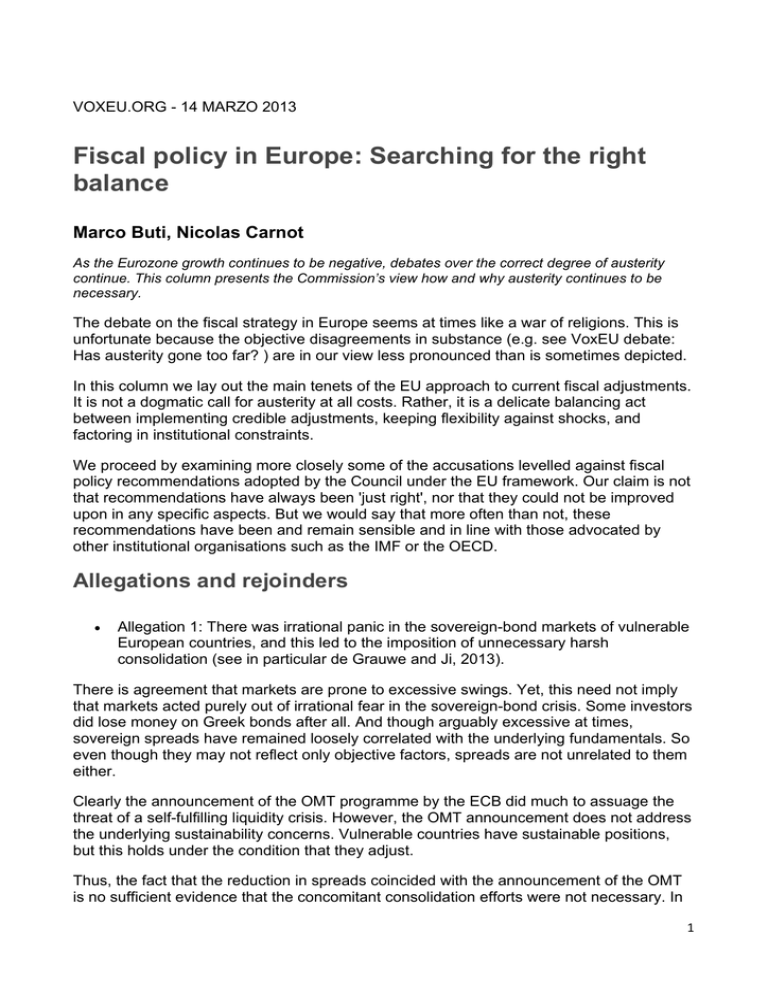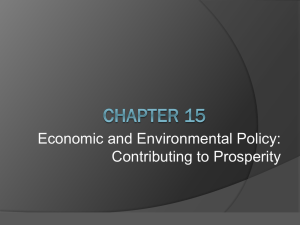Fiscal policy in Europe: Searching for the right balance
advertisement

VOXEU.ORG - 14 MARZO 2013 Fiscal policy in Europe: Searching for the right balance Marco Buti, Nicolas Carnot As the Eurozone growth continues to be negative, debates over the correct degree of austerity continue. This column presents the Commission’s view how and why austerity continues to be necessary. The debate on the fiscal strategy in Europe seems at times like a war of religions. This is unfortunate because the objective disagreements in substance (e.g. see VoxEU debate: Has austerity gone too far? ) are in our view less pronounced than is sometimes depicted. In this column we lay out the main tenets of the EU approach to current fiscal adjustments. It is not a dogmatic call for austerity at all costs. Rather, it is a delicate balancing act between implementing credible adjustments, keeping flexibility against shocks, and factoring in institutional constraints. We proceed by examining more closely some of the accusations levelled against fiscal policy recommendations adopted by the Council under the EU framework. Our claim is not that recommendations have always been 'just right', nor that they could not be improved upon in any specific aspects. But we would say that more often than not, these recommendations have been and remain sensible and in line with those advocated by other institutional organisations such as the IMF or the OECD. Allegations and rejoinders Allegation 1: There was irrational panic in the sovereign-bond markets of vulnerable European countries, and this led to the imposition of unnecessary harsh consolidation (see in particular de Grauwe and Ji, 2013). There is agreement that markets are prone to excessive swings. Yet, this need not imply that markets acted purely out of irrational fear in the sovereign-bond crisis. Some investors did lose money on Greek bonds after all. And though arguably excessive at times, sovereign spreads have remained loosely correlated with the underlying fundamentals. So even though they may not reflect only objective factors, spreads are not unrelated to them either. Clearly the announcement of the OMT programme by the ECB did much to assuage the threat of a self-fulfilling liquidity crisis. However, the OMT announcement does not address the underlying sustainability concerns. Vulnerable countries have sustainable positions, but this holds under the condition that they adjust. Thus, the fact that the reduction in spreads coincided with the announcement of the OMT is no sufficient evidence that the concomitant consolidation efforts were not necessary. In 1 fact, fiscal adjustment and the possibility to activate the OMT are arguably in strong complementarity. And a growing perception that adjustments are underway, as evidenced by significant progress in reducing deficits and restoring external positions, likely also contributed to the improvement in markets. Now, it may be argued that consolidation efforts, while necessary, were not needed to the extent prescribed. This leads to the next point. Allegation 2: The adjustment is too frontloaded. There is widespread agreement that fiscal consolidation should be pursued in most European countries. This is the view of the IMF, the OECD and the Commission. It is important to underline this area of agreement. Once it is admitted that fiscal adjustment is due, the issue becomes not one of principle, but one of degree. Many commentators say the problem is rather that adjustment is overly frontloaded, especially for the Eurozone periphery (e.g. Wolf, 2013). When setting the pace of fiscal adjustment, one important consideration is the economic outlook, including what we know of the short-term effects of consolidation (the multiplier). As compared with usual circumstances, there are reasons to expect higher multipliers in an environment of weak activity, lack of room for a supportive monetary policy, and tight financing constraints for private agents. All else equal, this calls for spreading out adjustments over time. The argument, also inspired by the Japanese experience (Koo, 2008), is to sequence private and public deleveraging. There are several opposite considerations however. First, one cannot be sure by when and how much the fiscal multiplier could fall in the future (Wolff, 2013). Then, while consolidation may be now more costly than in normal times, no or limited consolidation may in some cases have even worse consequences, notably if it triggers market expectations of a sovereign default and a liquidity crisis (Corsetti, 2012). This risk might have been recently lowered with the possibility of the OMT, but as noted above, this does not remove the need to demonstrate early commitment to fiscal consolidation, Another point is simply basic arithmetic: when the scope of required adjustment is large on the medium-term, even a gradual consolidation strategy spreading out consolidation over several years in broadly equal instalments will translate in not-insignificant fiscal effort from the beginning. Public sustainability gaps are at historic highs in a number of countries (European Commission, 2012a). In addition, stressed Eurozone countries face a big overall external challenge, unlike Japan in the 1990s. That requires an adjustment of the nation as a whole that is bound to be painful, whatever the exact distribution between public and private deleveraging. Overall, the policy implications require treading a fine line. The IMF considers a structural adjustment pace of 1% a year as a useful guideline, with needed differentiation according to the country situation (IMF, 2012). The SGP requires an annual structural adjustment of 0,5%, and more in the case of vulnerable countries. Country-specific features are important as well to consider (Gros, 2013). In practice, policy prescriptions under the E(M)U framework have struck a balance between the conflicting considerations. It should be recalled that the fiscal exit strategy originated in the early response to the crisis in the form of a fiscal stimulus in 2009/2010. Many initial recommendations under the excessive deficit procedure (EDP) were drafted in 2 this period, where it was agreed that the initial fiscal relaxation should be followed by fiscal retrenchment to stabilise and reduce debts. Recommendations set out at the time, of which a number remain in place, charted a path of sustained but spread out adjustment over several years, and with more effort required when the sustainability challenge is bigger. The recent international consensus is that fiscal consolidation needs to continue at a gradual and sustained pace, with fiscal adjustment in most advanced economies broadly appropriate (IMF, 2013). The precise pace of consolidation remains a delicate balance in each country specific cases, and may always be discussed. For example, future recommendations could better factor in the consequences of changes in growth models (such as rebalancing towards the tradable sector) in terms of lower tax elasticities. Allegation 3: The Commission follows an inflexible approach. In a sense, this criticism comes at a paradoxical time. The Commission has taken the initiative by proposing to extend deadlines for correcting the excessive deficit in several countries: Ireland, Portugal, Greece and Spain have already benefited from such flexibility. When recently presenting its winter forecast, the Commission has made clear that other extensions could be considered this spring. An important aspect of the EU fiscal framework is the weight given to structural targets, rather than just the overall deficit of a country (Buti and Pench, 2012). The reliance on structural targets provides both predictability and flexibility. The predictability stems from the fact that countries can embark on a 'steady structural approach'. The flexibility lies in allowing the automatic stabilisers to play out around the (structural) path of adjustment. Unless warranted by an overwhelming financing constraint, there is generally no need to chase nominal targets when growth disappoints. Of course cyclically adjusted balances are not without limitations either, based as they are on partly conventional assumptions. The surveillance framework is being developed to cope with these limitations (European Commission, 2012b). The simple allegation that the Commission pursues austerity inflexibly does not hold. Nor obviously does the opposite accusation that the framework is being weakened by downplaying the role of headline balances. The size of the fiscal adjustment already produced in vulnerable countries and elsewhere is testimony against that. Allegation 4: Fiscal consolidation is not politically or socially sustainable. There is no denying that the adjustments undergone by stressed countries are severe. This may strain social cohesion. However, a lot can be done both to soften the consequences of adjustments, and accelerate the return to sustainable growth. The composition of fiscal adjustment warrants attention. One needs to pick-up growthfriendly measures in an encompassing manner. Spreading the costs across the population and confronting vested interests help generate a sense that everyone pays their fair share. Some fiscal reforms, such as pension reforms, can improve sustainability and mediumterm growth without weighing on aggregate demand. Structural reform is another aspect, which goes hand in hand with fiscal consolidation in the present juncture (Buti and Padoan, 2012). Structural reforms improve efficiency, but 3 are also important when it comes to sharing the cost of adjustment in an equitable manner (Coeuré, 2013). For example, flexible work arrangements reduce the impact of downturns on outright layoffs. Reducing rents in product markets fosters the pass-through of wage restraint to prices, supporting household purchasing power. In other cases (e.g. employment protection legislation), reforms would not cushion the impact of negative shocks, but favour a stronger upturn. On the financial front, the deleveraging drag will be lowered by efficient bankruptcy procedures and genuine financial repair that allows lending to dynamic parts of the economy to go unhindered. Ensuring the effectiveness of monetary policy and restoring credit channels soften the costs of consolidation too. In countries inside or outside the Eurozone under a EU-IMF programme, efforts have been taken by the governments concerned and the troïka (Commission, IMF, ECB) to embed equity considerations in fiscal adjustment plans. Tax measures have focused on higher income brackets, and cuts in government wages or social benefits have often spared the lowest income levels. In some of the countries, the internal and external imbalances were so large and deep-rooted that radical choices had to be considered to rebuild their economic and policy credibility. Allegation 5: The Commission's approach is one-sided. It puts all the burden of adjustment on debtor countries. Several observers have pointed to the spillover implications of fiscal policies, and possibly insufficient policy coordination in the EU (e.g. Holland and Portes, 2012). We would agree that the symmetry of the adjustment is a legitimate concern. There are ways to favour a coordinated approach to rebalancing, but the currently available tools also present limitations. For vulnerable countries of the Eurozone that face a large external sustainability gap, external growth is the only sustainable way to grow out of their debts. They must undergo rebalancing. But their adjustment should not be hampered, and ideally be fostered by concomitant changes elsewhere. The improved current balances in the periphery thus have to be matched by rebalancing trends also in Eurozone countries that feature large current account surpluses. Policies and reforms supporting demand in these countries have a role to play. In Germany, the fiscal stance is now broadly neutral, hence consistent with the call for a differentiated fiscal stance according to the budgetary space. Reforms advocated by the Commission and the Council in labour and product markets or the tax system should contribute to raising domestic demand. There is also an increasing willingness to allow wages to reflect the higher productivity in surplus countries. And since fiscal consolidationcum-deflation is likely to be self-defeating, re-establishing competitiveness across the area implies higher than average inflation in stronger countries, provided price stability in the Eurozone and inflation expectations remain well anchored. The discussion also has implications for the long-run improvement of EMU architecture. The current situation appears as a cas d'école for the potential attraction of a 'fiscal capacity' at the central level, in the form of a stabilisation instrument, which the Commission has proposed in its Blueprint on the future of EMU (European Commission, 2012c). A dedicated stabilisation fund could improve the conduct of fiscal policies 4 throughout the cycle by enforcing tighter policies in good times and providing additional leeway for cushioning downturns. Such a tool could strengthen the existing automatic stabilisers while maintaining a credible rule-based framework. It would be particularly useful in the current predicament characterised by large cyclical differentials across the zone as well as a not insignificant average output gap. The potentialities of such an instrument are to be further explored analytically, even if the Commission blueprint considers it as a long-run prospect following deeper integration, rather than as a tool for tackling the current crisis. Editor's note: This column is adapted from Buti and Carnot (2013). References Buti M and N Carnot (2013), "The debate on fiscal policy in Europe: beyond the austerity myth", Ecfin Economic Briefs 20, March. Buti M and P C Padoan (2012), "From a vicious to a virtuous cycle in the Eurozone – the time is ripe", VoxEU.org, 27 March. Buti M and L Pench (2012), "Fiscal austerity and policy credibility", VoxEU.org, 20 April. Coeuré, B (2013), "Adjustment and growth in the Eurozone economies", Speech at the Nova school of business and economics and the Banco de Portugal, February. Corsetti, G (2012), "Has austerity gone too far?", VoxEU.org, 2 April. De Grauwe P and Y Ji (2013), "Panic-driven austerity in the Eurozone and its implications", VoxEU.org, 21 February. European Commission (2012a), "Fiscal sustainability report 2012", European Economy 8, December. European Commission (2012b), 2012 report on public finances in EMU, European Economy 4, July. European Commission (2012c), "A blueprint for a deep and genuine EMU – Launching a European debate, Communication from the Commission", COM 2012(777). Gros, D (2013), "Learning from small countries? Contemporary Nordic Sagas", CEPS Commentaries, February. Holland D and J Portes (2012), "Self-defeating austerity?", VoxEU.org, 1 November. IMF (2012), "Nurturing credibility while managing risks to growth", Fiscal Monitor Update, July. IMF (2013), "Global Prospects and Policy Challenges", Note for the Group of Twenty, February. Koo, R (2008), The holy grail of macroeconomics: Lessons from Japan's great recession, Wiley. 5 Wolf, M (2013), "The sad record of fiscal austerity", Financial Times, 27 February. Wolff, G (2013), "Austerity needed to start, now we need a fiscal union", Bruegel blog, 25 February. 6








